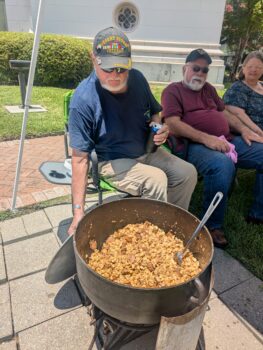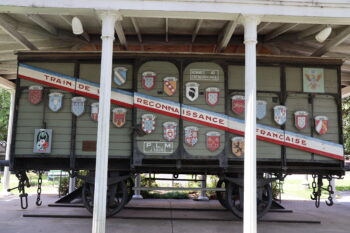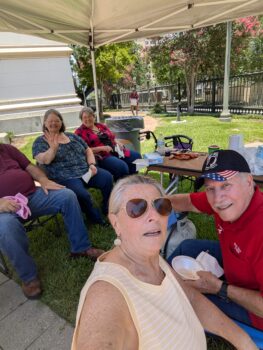A Taste of Gratitude: Honoring the Merci Train in Cajun Country
🇫🇷 A Taste of Gratitude: Honoring the Merci Train in Cajun Country 🇺🇸
By [Thann Dauterive]
In Louisiana, celebrations aren’t reserved just for holidays or festivals—they’re a way of life. Whether it’s a crawfish boil on a back porch or zydeco music in the streets, honoring tradition and history runs deep in the bayou. But on a recent visit to the Old State Capitol in Baton Rouge, I walked into something unexpected: a celebration that wasn’t about revelry, but remembrance.
It was there, under the towering Gothic spires of Louisiana’s former capital, that Urs and I stumbled upon a lesser-known chapter of post-WWII history—one carried on the rails of time and remembered by the proud Cajun veterans of Pierre Part, Louisiana.
A Cajun Welcome You Can’t Refuse
As we passed through the iron gates, we were greeted by a cheerful group of veterans, men and women speaking with the unmistakable rhythm of Cajun French. Their voices carried warmth, pride, and invitation.

“Y’all come get you some jambalaya!” one man called out, standing beside a massive cast-iron pot bubbling over a gas burner.
Now, if there’s one thing you don’t do in Louisiana, it’s turn down a plate of home-cooked Cajun food. Before we could utter a polite refusal, two overflowing plates were placed in our hands—enough to feed a small army.
What started as a simple food offering turned into something far richer: a living, breathing history lesson about the Merci Train—a story very few people know, but everyone should.

What Was the Merci Train?
After WWII, France was devastated. In 1947, Americans organized the Friendship Train, sending over 700 boxcars filled with food and supplies to help French and Italian citizens recover from the destruction of war.
In return, the people of France launched the Merci Train—a heartfelt gesture of gratitude. In 1949, 49 antique boxcars (known as “40 and 8s,” “40 Hommes/8 Chevaux”, because they could carry 40 men or 8 horses) were filled with gifts from everyday French citizens. Over six million people donated handcrafted items: dolls, clothing, sculptures, furniture, and art. These cars were sent to each of the 48 U.S. states, with one shared between Hawaii and Washington, D.C.
Louisiana’s car found its final home on the grounds of the Old State Capitol. And each year, members of American Legion Post 328 in Pierre Part return to honor that gesture of friendship and the bond it represents.
Meeting the Guardians of the Merci Train
As we savored every bite of smoky, spiced jambalaya, we met a kind and animated gentleman named Mr. Ray Boy, a veteran with stories etched into the corners of his smile.
He explained that their post had become the adopted “keepers” of Louisiana’s Merci boxcar. Every year, they host a celebration on these very grounds with food, music, speeches, and a history lesson passed down with pride.
These men and women—veterans of Vietnam, Desert Storm, and more—have taken it upon themselves to preserve this piece of history. Not in a museum, but in real life, through storytelling, gathering, and Cajun hospitality.

A Language of the Land
Being among the people of Pierre Part, Louisiana, was like stepping into a different time—and a different soundscape. The way they speak, sing, and joke is infused with Cajun, a beautiful dialect influenced by French settlers from long ago.
Though I have French heritage myself, I fumbled through a few rusty childhood phrases. They laughed, not at me but with joy, and Mr. Ray Boy responded in a rapid-fire Cajun French that Urs (thankfully, thanks to his Swiss upbringing) could somewhat follow.
In those moments—piecing together meaning from shared words, gestures, and laughter—we felt a deep sense of connection. One that crossed language and culture, anchored in mutual respect.
A Forgotten Story Worth Remembering
It’s hard not to wonder: “Is the story of the Merci Train taught in schools today?” Probably not. Yet, it’s a symbol of something we desperately need more of—international friendship, generosity, and gratitude.
Of the 49 original boxcars, only 43 remain. Some were destroyed by fire or scrapped; others simply disappeared. But in Baton Rouge, one stands proud, watched over by the people who understand its significance best.
These boxcars didn’t just carry gifts—they carried hope, and a deep, personal “thank you” from a nation that hadn’t forgotten who had stood by them.
Final Thoughts
The Merci Train isn’t just about history—it’s about memory, community, and carrying stories forward. And in true Louisiana fashion, it’s also about gathering around good food, warm conversation, and the kind of hospitality that fills your heart as much as your stomach.
So next time you find yourself near Baton Rouge, take a walk by the Old State Capitol. And if you’re lucky enough to visit when the veterans from Pierre Part are in town, say yes to the jambalaya.
You might just come away with more than a great meal. You might leave with a piece of history that still matters.
I would enjoy hearing from you, your thoughts and prospective.
Have you ever visited a Merci Train boxcar or heard about this story before?
Share your thoughts or memories in the comments below!
~~~~~~~~~~~~~~~~~~~~~~~~~~~~~~~~~~~~~~~~~~
🖊️ We’d love to hear from you!
Merci for visiting. If you enjoyed this Short Haul, then come along for the extended journey as we explore the Old State Capitol in Baton Rouge, Louisiana, and the historic Bayou Plaquemine Locks. Adventure’s just a click away!
Exploring Baton Rouge: A Step Back in Time at the Old State Capitol
Bayou Plaquemine: Locks, Family Ties & A Journey Through Time
* Pierre Part is located in Assumption Parish, Louisiana, United States. Population 3000.
You can follow me on Facebook at: Take Another Route


